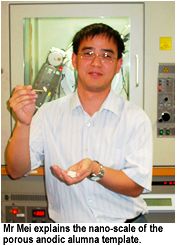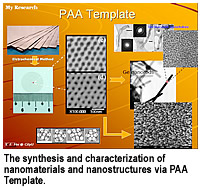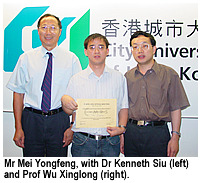Research student receives young scientist award
Karen Lai
"Microelectronics technology is an exciting interdisciplinary research area for studying materials, and the molecular components of electronics," Mr Mei said. It is fascinating to me and holds great promise for the future advancement of processors in microelectronics industry.”
The largest conference in
A novel fabrication method
In conducting his research, Mei employs a self-organized effect to fabricate a porous anodic alumna (PAA) template, which shows a nanopore array with different size and ordered arrangement. He uses the template-assistant fabricated method to synthesize semiconductor nanomaterials and their arrays, as well as other functional nanostructures, which cannot be produced in nano-scale by conventional microelectronics technology.
Mei's research provides microelectronics technology with scientific explanations and possible alternatives for its future development, especially related to the components, energy band gap and defects of semiconductors. By using semiconductor nano materials to assemble
high-performance nano devices, he attempts to provide possible alternatives to replace conventional transistors. This R&D area has been pursued by leading chip-making corporations such as Intel and IBM. Successful application of the research would enhance the development of high technology products such as the central processing units in computers.
Revelling in the world of nanoscience
Mei has been enamored of nanotechnology since he was a research student at Nanjing University. There, he specialized in silicon-based light-emitting nanomaterials. Mei decided to continue his pursuit of nanotechnology at CityU once he completed his Master’s degree in 2002. At that time, his teacher, Professor Wu Xinglong, came to CityU as Visiting Fellow and recommended that Mei study a PhD degree here. With offers from other leading universities in
“Mei’s success is due to his diligence and innovative ideas,” Dr Siu remarked. Dr Siu said that at CityU Mei's ideas became more mature. “Mei's receiving the award attests to the fact that CityU provides the best environment and technologies to nurture young talents in the field,” Dr Siu said. “Nanotechnology is so fascinating a research area that every tiny aspect of it can have tremendous impact," Mei added. "I explore the world of nanoscience just like an astronomer exploring the beauty of the galaxy.” He likened the nano component of objects to wonderful landscapes, cityscapes, mountains and seas of the world. “In application, the technology has great potential to improve daily life. I enjoy looking into the tiny components and working out alternative solutions to the current findings.”
The European Materials Research Society was founded in 1983 in


